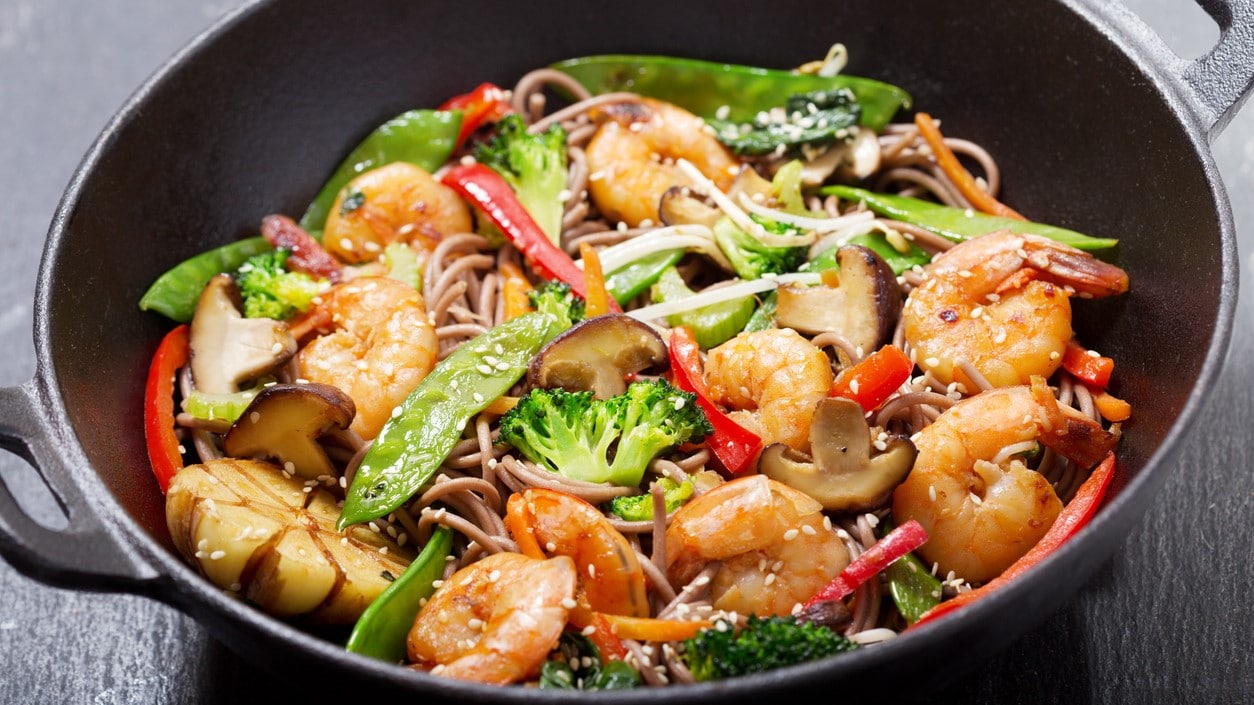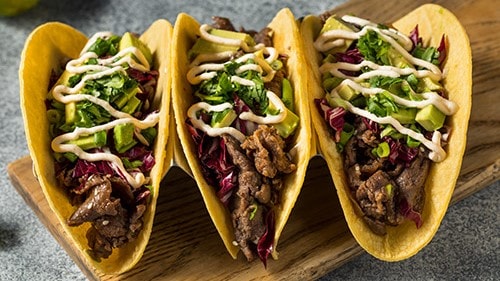At a glance
Here are answers to frequently asked questions (FAQ) about how to consider cultural food preferences in food service. See how to identify culturally preferred foods and work with vendors. Also learn how to include support for culturally preferred foods in contracts and policies.

Introduction
This information is intended mainly for federal, state, and local public health practitioners working in food service. It may also help vendors and others seeking to offer foods that meet nutrition standards and are culturally preferred by the populations they serve. This information was developed to:
- Explain the importance of providing culturally preferred foods.
- Suggest ways to collaborate with vendors and other partners.
- Guide the incorporation of cultural preferences in food service.
What are culturally preferred foods?
"Culturally preferred foods" describes safe and nutritious foods that meet diverse tastes and needs of customers based on their cultural identity. For example, people who identify with Muslim or Jewish religious traditions may want foods that are halal or kosher, respectively.
"Culture" can be defined by membership, such as racial, ethnic, linguistic or geographic groups1. Culture may also be a collection of a specific group's beliefs, values, customs, ways of thinking, communication, and behaving.1
Why are culturally preferred foods important?
Offering affordable, culturally preferred food options that are in line with the Dietary Guidelines for Americans allows customers to choose foods that meet their needs. Serving culturally preferred food options expands opportunities for customers to select familiar and healthier foods they like. Improved diet quality may positively impact customers' health. In addition, other customers may learn about and enjoy different cuisines.
Which influences customer food choices?
Beyond cultural preferences, customers choose foods for a variety of reasons, including:
—Price, convenience, and taste.
—Agricultural growing techniques, such as organic farming.
—Sourcing of products, such as local or regional foods.
—Food preparation methods, including the use of specific ingredients.
—New foods or cuisines.
—Foods that help prevent or manage chronic health conditions.
—Food allergies or intolerances.
How do I get support for culturally preferred foods?
Draw on the expertise of your food service guidelines team, including food service vendors and staff, organizational leadership, and worksite wellness staff. Food service vendors and staff may ensure buy-in and feasibility for including diverse food offerings.
If your food service guidelines team does not already represent the diversity of your customers, consider how to include these perspectives. This is a critical step. However, remember that one person's opinions do not necessarily represent an entire culture.2
Discuss with your food service guidelines team the importance of adding culturally diverse foods in various venues, such as cafeterias and vending. With your team you may:
- Develop a plan for incorporating culturally preferred foods into food service guidelines.
- Collect ideas and feedback on culturally preferred foods from food service employees and their customers via surveys, interviews, and focus groups.
- Collaborate with food vendors to improve offerings of culturally preferred nutritious options based on customer feedback.
External partners, such as professional organizations, can provide resources. They can also help source cultural foods and conduct other activities to help achieve your goal.

How do I identify culturally preferred foods?
Gather preliminary information about the customer base
Conduct a comprehensive baseline assessment to identify your customers' cultural backgrounds. The human resources department may be able to share some sociodemographic characteristics of customers at the workplace. Next, work with your food service guidelines team to carry out the appropriate qualitative assessment(s) of your customers' food preferences.
Depending on your setting and capacity, you may conduct observational assessments, surveys, informal interviews, and focus groups with customers from diverse cultures. These assessments can reveal customers' perceptions of cultural food offerings and food preferences. Assessments can also identify key facilitators and barriers to offering culturally preferred food options in your setting.
Consider gathering data from food service managers and potential new customers, such as employees who don't currently frequent the food venue.
Assessments can be conducted routinely, as needed. Also, work with the food service vendor to avoid duplication of effort. Food vendors may already conduct assessments as part of their contractual scope of work.
Develop and conduct a customer survey
Define the goal of your assessment with your food service guidelines team before determining survey questions for your assessment. For example, your primary goal may be to identify top cultural foods enjoyed by your customers to encourage vendors and food service staff to add them to the menu rotations.
Make sure that your questions lead to attaining your goal. Questions can be multiple-choice, scaled (such as Likert), open-ended, qualitative, quantitative, or combination. Work with your food service guidelines team to identify the appropriate dissemination plan. You may collect surveys using pen and paper or a web-based platform. Consider including a quick response (QR) code for customer convenience if using a web-based platform.
Consider asking customers questions about cultural foods:
- Types of foods embraced by their culture.
- Cultural habits and traditions, such as religious observances and holidays, that are related to food.
- Preference for eating foods of their culture when away from home versus foods typically served in food service settings.
- Facilitators to cultural food purchases, such as visual appeal, prominent display, or low cost.
- Barriers to cultural food purchases, such as lack of authenticity or variety or does not represent customers' cultures.
- How often customers eat at the setting and if they would eat there more frequently if culturally desired foods were served.
Consider asking customers questions about foods in general:
- Use of food to prevent or manage chronic health conditions.
- Recommendations for improvements to food offerings.
- Preferences for specialized items to eat food with, such as chopsticks or injera.
- Favorite items on the current menu.
Assess the current menu
Examine your setting's menu cycles to determine whether the foods offered represent customers' views and cultures. This will allow you to see opportunities for improvement.

How do I tell vendors about adding cultural foods to menus?
If your food vendors are not bound by contract to add culturally diverse foods, ask them if it would be feasible to do so. Any changes must be within the scope of their contract and budget without incurring additional costs.
Consider asking the food vendor questions about the following:
- Willingness to offering culturally preferred foods and promote new menu items.
- Cost-effectiveness of sourcing ingredients.
- Ability to offer culturally preferred foods that also meet nutrition standards as outlined in Guideline 2 in the Dietary Guidelines for Americans.
- Whether specialized kitchen equipment might be needed.
- Knowledge and experience cooking diverse cuisines and types of foods and cuisines in which vendors would make a profit.
- How often to introduce new or seasonal recipes to the menu rotation.
- Willingness to offer specific dishes tied to religious observances.
If you include sourcing culturally diverse foods in your vendor contracts, the vendor may assess progress voluntarily or as the contract stipulates. Otherwise, consider conducting and sharing assessment findings with your food vendor.
How do I help vendors include customer cultural preferences?
Identify cross-cultural ingredients
Of the cuisines identified in the customer assessments, suggest that the vendor consider a few common ingredients. For example, rice, beans, and corn are popular staple foods across many cultures. They are inexpensive, easy to find, and likely already being purchased and used. Offering dishes that use these ingredients may be a cost-effective approach, especially if the vendor has limited access to specialty foods. Consider what is easiest for your vendor to implement and start with that. Ask the vendor to add other menu items later.

Consider fusion of flavors
The vendor may want to experiment with fusion cuisine to create new cuisines that are appealing across cultures. Fusion cuisine combines the flavors of two or more cultures to develop interesting, yet familiar dishes. The vendor may identify existing recipes to make substitutions without incurring additional costs. For example, if the recipe calls for cream, the vendor can use coconut milk instead to add Thai flavors.
Spices, herbs, and oils can infuse dishes such as bulgogi tacos or spaghetti with curried meatballs with cultural flavors. Although fusion foods offer familiarity, they are still different. They should not be considered "traditional" or representative of the culture. Consider adding an assessment question about customer receptivity to fusion foods to determine whether customers would consider that an acceptable alternative.
Use food stations or bars
Offering food stations or bars is another way to add variety to a menu. They give customers the autonomy to select their preferred foods while encouraging them to try foods from other cultures. Explore using food bars to offer familiar, healthy, and culturally diverse foods. Examples include taco, ramen, or pho bars. Encourage customers to try these foods by using creative naming, taste testing, alterations to the food display, and other behavioral design strategies. These approaches can positively influence customer purchases and increase venue profits.
How can vendors source culturally preferred food?
Staple ingredients
The vendor may use common staple ingredients across culturally preferred cuisines because they may be relatively inexpensive and readily sourced. However, remember that some cultures may have specific preferences about varieties, growing practices, and sourcing.
Rice is an example. American Indians in the Midwest may prefer wild rice sourced from farms owned by American Indians. Similarly, members of Southwest American Indian tribes may prefer products with blue corn instead of yellow corn. South Asian cultures may prefer basmati or long-grain rice. In contrast, East Asian cultures may find short-grain or sticky rice more acceptable.
Spices and herbs
Spices can infuse a dish with the flavors of a culture. The distributor may not have specific spices or flavorings needed for a cultural cuisine. In that case, the vendor can check with local ethnic markets or ask local restaurants where to source specialty ingredients.
Meats and produce
The vendor can buy meats and produce from local growers, if feasible, to reduce the supply chain distance. Vendors can consider buying from farmers and ranchers who use desired cultural practices and techniques when processing meats and growing produce.
How can contracts and policies help?
To ensure cultural food goals are met, consider adding a cultural food standard to your organization's food service guidelines policy. It could state something like, "All onsite food vendors are encouraged to offer a variety of foods related to the cultural heritages of customers and meet the Dietary Guidelines for Americans."
Alternatively, your organization could solicit food vendors willing to assess customers' cultural food preferences and include cultural foods in the menu cycles. This can be done via the Request for Proposals (RFP) process. Review bids and select a qualified vendor. Then make sure all cultural food standards are stipulated in the final contract language and vendor's scope of work.
The policy section of the Food Service Guidelines Implementation Toolkit provides more information on standards for vendor contracts, RFPs, and organizational policies.
Sample language for RFPs
This sample language can support cultural food goals in an organization's official RFP or solicitation process for food vendors:
"This solicitation seeks to obtain bids from qualified vendors who can ensure that food service offerings are culturally desired and have been adapted to meet regional and client-centered preferences. In addition, vendor adaptations must still meet the specified food and nutrient requirements included in the 2017 Food Service Guidelines for Federal Facilities for prepared foods and packaged snacks at the standard or innovative level of implementation."
Next steps
Return to "Building Blocks"
Use the "Building Blocks of Food Service Guidelines" to navigate to other parts of the Food Service Guidelines Implementation Toolkit.
- Culture and Language. Centers for Disease Control and Prevention. December 27, 2022. Accessed March 29, 2024. https://www.cdc.gov/healthliteracy/culture.html
- Cultural Considerations in Nutrition and Food Preparation. California Department of Social Services. October 2013. Accessed March 29, 2024. https://www.cdss.ca.gov/agedblinddisabled/res/VPTC2/9%20Food%20Nutrition%20and%20Preparation/Cultural_Consider_in_Nutrition_and_Food_Prep.pdf


